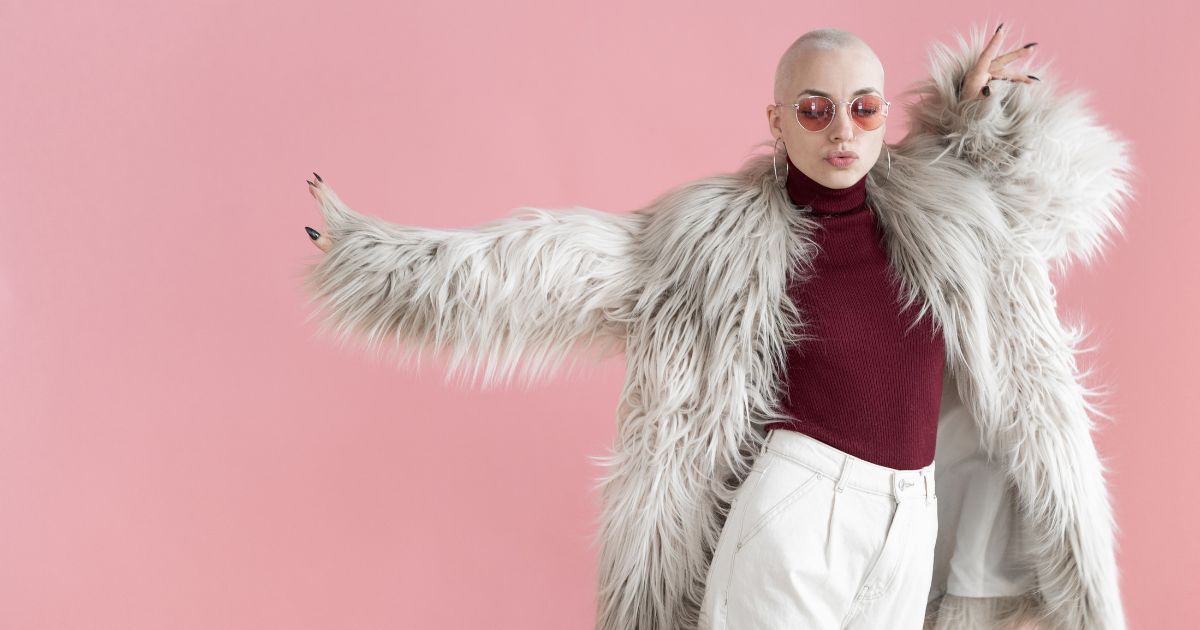By Srinidhi Madurai K., FLJ Intern
When one thinks about fashion and animal rights, the first thing that comes to mind is the picture of Gisele Bundchen on the 2002 Victoria’s Secret runway, trailed by activists holding up signs saying “Gisele: Fur Scum.” The activists were from PETA, People for the Ethical Treatment of Animals, protesting against the contract Bündchen had recently signed with fur company Blackgama. This incident sent ripples across the fashion world, sparking conversation about the ethics and morality of the industry concerning animal rights.
A shadow of ethical concerns looms large in the glitz and glamour of the fashion world, particularly when it comes to the treatment of the environment and animals. From sourcing materials to production methods, the fashion industry’s practices have a direct impact on the well-being of animals. This article delves into the various dimensions of this conflict, exploring the ethical concerns, legal protections for animal rights, and suggesting ways in which both consumers and industry professionals can contribute to making the fashion industry more ethical.
Animal Rights and Fashion:
Animal rights are grounded in the belief that animals deserve to be treated with respect and should not be subjected to abuse or exploitation by humans. This principle has roots in ancient civilizations, where religious codes emphasized the fair treatment of all living beings. Recognizing animal rights is crucial because it acknowledges that animals have inherent value beyond their usefulness to humans and that they can experience emotions like suffering, pain, love, and joy. It is our moral duty to consider their feelings when we cause them harm.
Unfortunately, this moral obligation is often disregarded due to human greed. The fashion industry, for instance, is responsible for the cruel deaths of over 50 million animals each year, as reported by Born Free USA in 2014. To understand the extent of this exploitation, we must examine the various ways in which the fashion industry profits from animals.
- Fur Production
The global fur retail trade, valued at $20.1 billion in 2021 according to the University of Copenhagen, has been the subject of controversy and scrutiny. The European Union, with 5,000 farms contributing to 50% of global fur production in 2018 (International Fur Trade Federation), holds the title of the largest fur producer.
The production process involves fur farming, where animals like minks, foxes, chinchillas, rabbits, and others are bred in captivity, cruelly killed through methods like strangulation and electrocution, and then skinned. Animals hunted in the wilderness are often left to die after being trapped and skinned.
These practices involve severe ethical violations, from the inhumane treatment and brutal killing of animals to the potential harm caused to ecosystems and endangered species. Fur treatment is also unsustainable, requiring excessive water, power, and chemicals.
Thankfully, the industry is shrinking due to actions taken by brands, organizations, governments, and consumers. The global fur retail value decreased by $9 billion from 2017 to 2021 (University of Copenhagen). Many fashion houses, including Gucci, Versace, Michael Kors, Vivienne Westwood, and Armani, have abandoned the use of animal fur in their collections. In a 2018 interview, Donatella Versace stated, “Fur? I’m out of that. I don’t want to kill animals to make fashion. It doesn’t feel right.”
This decade has witnessed a revolutionary wave of animal rights actions in the fashion industry, leading to a significant shift away from the use of fur.
- Leather and Exotic Skin
In 2020, PETA exposed the distressing conditions of animals in LVMH’s supply chain through an undercover investigation. The hidden camera footage revealed alligators and crocodiles packed in concrete pits, awaiting their brutal deaths. Workers were seen savagely killing these animals, some still conscious and struggling even minutes after the attempted killing. LVMH’s response to the findings was widely criticized by the public and PETA, with this not being the first instance of animal cruelty within their supply chain.
The global leather industry, valued at $242.85 billion in 2022 and predicted to grow 6% annually until 2030, capitalizes on leather as a symbol of luxury and status. Fashion brands like Gucci, Hermes, and Fendi utilize leather in their products such as shoes, bags, and apparel.
However, the ethical and environmental concerns associated with the industry extend beyond animal welfare. Leather tanning involves excessive water usage, chemical pollution, and health risks for workers. Additionally, the sourcing of exotic animals for leather contributes to deforestation and habitat destruction.
To address these issues, consumers are increasingly turning to ethical alternatives like vegan leather, recycled leather, and second-hand options. Innovations in vegan leather, such as synthetic materials, pineapple-based leather (Pinatex), and mushroom-based leather (Muskin), offer similar aesthetics to genuine leather without ethical and environmental drawbacks. Nonetheless, these alternatives may have their own limitations, such as the petroleum-based materials used in vegan leather contributing to plastic waste and potential differences in durability and customer appeal compared to real leather.
Further advancements in biotechnology and textiles are necessary to develop alternatives that replicate the qualities of leather while eliminating the ethical and environmental burdens associated with its production.
- Animal Testing
The skincare and beauty industry frequently conducts animal testing, resulting in the death of over 110 million animals annually in the US alone, as stated by PETA. These animals endure confinement, restraint, and various forms of physical and psychological torture.
Despite mounting public criticism and evidence suggesting its limited effectiveness, animal testing remains prevalent in the industry. Researchers have found that medical treatments developed through animal testing often do not successfully translate to human applications, as reported in The Journal of the American Medical Association. Consequently, the public’s growing opposition to animal testing drives the demand for innovative alternatives, such as cellular models and computer simulations, as replacements for animals in laboratories.
To promote more ethical practices, cruelty-free certifications are available to brands committed to eliminating animal testing from their processes. These certifications empower consumers to make informed choices and support businesses that prioritize animal welfare.
- Feather, Down, and Wool:
Down is the delicate layer of feathers found closest to the skin of birds, particularly in their chest area. This type of feather is highly sought after by manufacturers of down clothing and comforters because it is devoid of quills. Most down and feathers are obtained from ducks and geese after they are killed. However, birds in breeding flocks or raised for meat may endure the cruel practice of live plucking, where feathers are repeatedly plucked from their bodies while they are still alive.
In 2021, PETA conducted an extensive investigation into duck farms and slaughterhouses in Vietnam which claimed to produce “responsible down.” These farms were a part of the supply chains of GAP, H&M, Guess, and a dozen other companies. It exposed the vapid living conditions of the ducks, some immobilized due to infections and wounds. When it was time to slaughter the birds, they were tied upside down and stabbed in the neck while conscious. It exposed that when it comes down to it, down is never an ethical option. Artificial replacements for down and feathers are available in the market, but the luxury appeal of genuine down continues to dictate consumer preferences.
Conclusion: What can you do?
We all have a role to play in creating a fashion industry that respects animal rights. As consumers, we can make conscious choices, support ethical brands, and raise awareness through social media. As industry professionals, we can be informed advocates for animal welfare, collaborate with ethical suppliers, and drive positive change within our organizations. Together, we can build a fashion industry that prioritizes compassion and sustainability, ensuring a better future for both animals and the planet.
Bibliography:
Thomas, S. (2017). Fashion Ethics. United Kingdom: Taylor & Francis.
(n.d.). Coller Animal Law Forum Database. CALF. Retrieved May 19, 2023, from https://calf.law/database
Legislation Database – Global Animal Law GAL Association. (n.d.). Legislation Database – Global Animal Law GAL Association. https://www.globalanimallaw.org/database/index.html
Animal Welfare Board of India. (n.d.). Animal Welfare Board of India. https://www.awbi.in/policy_acts_rules.html
PETA Investigations – PETA Exposés and Undercover Investigations. (n.d.). PETA . Retrieved May 19, 2023, from https://investigations.peta.org/
India bans import of exotic skins used for leather or fur clothing and accessories. (2017, January 17). Times of India. Retrieved May 19, 2023, from https://timesofindia.indiatimes.com/home/environment/india-bans-import-of-exotic-skins-used-for-leather-or-fur-clothing-and-accessories/articleshow/56357714.cms
Singer. (n.d.). Animal Liberation.
The Ugly Truth: 50 Eye-Opening Animal Cruelty Statistics. (2023, January 5). WAF. Retrieved May 19, 2023, from https://worldanimalfoundation.org/advocate/animal-cruelty-statistics/
Gardetti, M. N. (2016, August 21). Sustainability in the Textile and Fashion Industries: Animal Ethics and Welfare. Textile Science and Clothing Technology, 47–73. https://doi.org/10.1007/978-981-10-2182-4_2
Leather Goods Market Size, Share & Trends Analysis Report By Type (Genuine Leather, Synthetic Leather, Vegan Leather), By Product, By Region, And Segment Forecasts, 2023 – 2030. (n.d.). In Grand View Research (GVR-3-68038-061-3). Retrieved May 19, 2023, from https://www.grandviewresearch.com/industry-analysis/leather-goods-market/methodology
Doke, S. K., & Dhawale, S. C. (2015, July). Alternatives to animal testing: A review. Saudi Pharmaceutical Journal, 23(3), 223–229. https://doi.org/10.1016/j.jsps.2013.11.002
Hackam, D. G., & Redelmeier, D. A. (2006, October 11). Translation of Research Evidence From Animals to Humans. JAMA, 296(14), 1727. https://doi.org/10.1001/jama.296.14.1731
Animal Issues | PETA. (n.d.). PETA. https://www.peta.org/issues/
Fur protesters disrupt Victoria’s Secret show. (2002, November 15). Cnn.Com. Retrieved May 19, 2023, from https://edition.cnn.com/2002/US/11/15/victorias.peta/
Otte Hansen. (2021, May 27). Global fur retail value. University of Copenhagen.
Otte Hansen. (2017, July 31). Global fur retail value. University of Copenhagen.
Fur Farming Europe: Regulations, Welfur and Sustainability • We Are Fur. (n.d.). We Are Fur. https://www.wearefur.com/responsible-fur/farming/fur-farming-europe/


















